#macrofossil
Text
Big Titted Wife Fucked and Spermed by Big Black Cock
Abella spreads her legs for a big cock
Russian teen big tits home Yoga Perv
Slut with nice ass in lingerie solo masturbation with a purple dildo
A primeira vez com nosso amigo que abordamos na rua convencemos ele a participar do nosso menage
Anal loving schoolgirl fucked in classroom
Thinking of coworker
Gay twink licking balls and cock wet nude twinks xxx The distorted
Horny Busty Lingerie Lesbians Eating Out & Dildo Fun
Tight pussy gettin fucked tinder date
#eavesdropped#champaks#bechamels#capitularies#skeletonlike#Edda#Sikeston#reluming#cataloging#subrhomboidal#acedy#johnny#macrofossil#Waicuri#cerebro-spinal#superoxygenate#unpackaged#wavy-edged#precarcinomatous#psychiatry
1 note
·
View note
Text
I have stumbled upon the horrors and they stared back at me <<<man who googled “root fragment” expecting to see plant roots and instead was greeted by teeth, or rather, the lack thereof
#jesus christ dude#it was just a hole in someones jaw#i love body horror but good god i need to bleach my eyes#im just trying to id plant macrofossils man!!!#ollie rambles
0 notes
Text

Trilobozoans (also known as triradialomorphs) are some of the more enigmatic members of the Ediacaran biota. In the past their unique three-way-symmetrical body plan was interpreted as linking them to groups like sponges, cnidarians, or echinoderms, but currently they're considered to be their own weird little phylum with uncertain evolutionary affinities, classified no more specifically than "probably some sort of early eumetazoan animal".
Lobodiscus tribrachialis is a newly-described member of this mysterious lineage. It lived in warm shallow marine waters covering what is now Southwestern China, and with an age of around 546 million years it's currently the youngest known trilobozoan, extending the group's time range by several million years.
About 3.7cm in diameter (~1.5"), it had the characteristic trilobozoan disc-shaped shield-like body, with a central depression surrounded by three triradially-symmetric lobes with branching ridges and grooves.
Its body would have been soft but fairly rigid, and it's not clear if it was capable of moving over the seafloor or if it had a more static lifestyle. Like its relative Tribrachidium it was probably a filter feeder, with the grooves on its surface directing water flow towards the central depression – and this surface ornamentation may also have been covered with cilia that actively caught and transported suspended food particles.
———
NixIllustration.com | Tumblr | Patreon
References:
Ivantsov, A. Yu, and M. A. Zakrevskaya. "Trilobozoa, Precambrian tri-radial organisms." Paleontological Journal 55 (2021): 727-741. https://doi.org/10.1134/S0031030121070066
Ivantsov, Andrey, Aleksey Nagovitsyn, and Maria Zakrevskaya. "Traces of locomotion of Ediacaran macroorganisms." Geosciences 9.9 (2019): 395. https://doi.org/10.3390/geosciences9090395
Hall, C. M. S., et al. "The short-lived but successful tri-radial body plan: a view from the Ediacaran of Australia." Australian Journal of Earth Sciences 67.6 (2020): 885-895. https://doi.org/10.1080/08120099.2018.1472666
Rahman, Imran A., et al. "Suspension feeding in the enigmatic Ediacaran organism Tribrachidium demonstrates complexity of Neoproterozoic ecosystems." Science Advances 1.10 (2015): e1500800. https://doi.org/10.1126/sciadv.1500800
Zhao, Mingsheng, et al. "A putative triradial macrofossil from the Ediacaran Jiangchuan Biota." Iscience 27.2 (2024). https://doi.org/10.1016/j.isci.2024.108823
Wikipedia contributors. “Lobodiscus.” Wikipedia, 29 Mar. 2024, https://en.wikipedia.org/wiki/Lobodiscus
Wikipedia contributors. “Trilobozoa.” Wikipedia, 10 Mar. 2024, https://en.wikipedia.org/wiki/Trilobozoa
#science illustration#paleontology#paleoart#palaeoblr#lobodiscus#trilobozoa#triradialomorpha#eumetazoa#animal#ediacaran#art#or maybe just precambrian disc golf
304 notes
·
View notes
Text
also. late quaternary extinction of a tree species in Eastern North America.
I've posted a little bit in the past about end-pleistocene megafauna extinctions, the overkill hypothesis, and the impact on "humans are the virus" type interpretations of ecology. This tree is the only documented end-Pleistocene plant extinction, which seems really striking, but this paper (from 1999) is like "yeah we haven't really studied it, and pollen deposits don't really allow for distinguishing plants on the species level, and most macrofossil sites have barely been analyzed."
I tried to do some research on end-pleistocene palynology in the USA and found this paper, which if anything gives a decent glimpse into what palynology does and doesn't allow us to analyze, and it is noted that "Nyssa, however, is distinctly entomophilous (Smiley Apiaries 2014), so just about any amount of its pollen in a sample suggests that the plants grew quite close to the site of deposition, where the discarded flowers accumulated. Because Nyssa is exclusively a freshwater entomophilous genus, the presence of its pollen in any significant quantity (>1%, F.J. Rich, personal observation) marks the site of a former freshwater wetland"
In other words, "Nyssa (blackgum) is insect pollinated, so its seriously weird that its pollen shows up in this fossil pollen sample, and would have to mean that there was a big grove of them with flowers falling to the ground right where the sample was collected."
Most of the species detected in this study are wind-pollinated species that are mega abundant and produce shit tons of airborne pollen, and they are identifiable down to either genus or family level. This means we can't say much about plants pollinated by insects, plants that were a small part of the total plants in the area, or plants that differed from modern ones only on species level.
Which means that it's misleading to say "there was only one End-Pleistocene plant extinction in USA" because we couldn't know that either way!
In fact the presence of plants like Torreya, Franklinia, and other "relict" plants along the Gulf Coast with ultra tiny ranges that likely used to be more widespread suggests that tons of plants could have gone extinct during the Last Glacial Maximum, since all it would take is a plant being 5% more intolerant to the glaciated climate than any of the numerous plants that got severely bottlenecked
It seems like the plants haven't gotten as much attention in research and that keeps being interpreted as "nah, there wasn't really an effect on the plants, only animals went extinct mostly" NO!!!!
178 notes
·
View notes
Link
First macrofossil record of Calophyllum in Thailand reported – The Lifestyle Insider
0 notes
Text
Conversations with Pang Ke: Unraveling the Mysteries of Horodyskia And How Ancient Macrofossils Shed Light on Early Eukaryotic Evolution.
The enigmatic Proterozoic macrofossil genus Horodyskia, characterized by strings of bead-like structures, offers vital insights into early eukaryotic evolution. Despite its global distribution and fossil records extending from the early Mesoproterozoic Era (~1.48 Ga) to the terminal Ediacaran Period (~550 Ma), Horodyskia’s biological affinity is debated, with theories ranging from brown alga to…
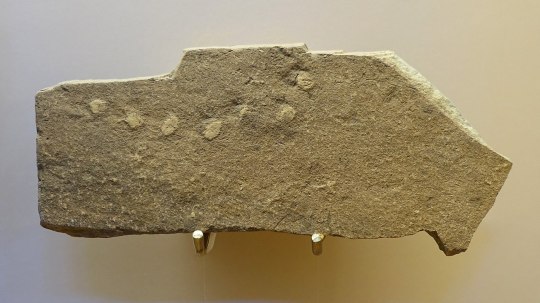
View On WordPress
#Asia#Australia#Conversations#eukaryotes#Europe#evolution#Featured#fossils#North America#South America
0 notes
Text
Bacterial bloom as the Earth thawed: Photosynthetic organisms during the Snowball Earth
https://sciencespies.com/nature/bacterial-bloom-as-the-earth-thawed-photosynthetic-organisms-during-the-snowball-earth/
Bacterial bloom as the Earth thawed: Photosynthetic organisms during the Snowball Earth
Some researchers hypothesize that ice sheets enveloped the earth during the Marinoan glaciation (650-535 million years ago) in what is dubbed the “Snowball Earth.” The glaciation also impacted the climate and chemical compositions of the oceans, restraining the evolution of early life. Yet, as the earth warmed, and the Ediacaran period dawned, biotic life began to evolve.
A research team from Tohoku University has unveiled more about the evolutionary process of the Marinoan-Ediacaran transition. Using biomarker evidence, they revealed possible photosynthetic activity during the Marinoan glaciation. This was followed by photosynthetic organisms and bacteria entering a period of low productivity. However, as eukaryotes expanded during the early Ediacaran period, they blossomed.
Dr. Kunio Kaiho, who co-authored a paper with Atena Shizuya, said, “Our findings help clarify the evolution of primitive to complex animals in the aftermath of the Snowball Earth.” Their paper online was published in the journal Global and Planetary Change on August 8, 2021.
The late Neoproterozoic era (650-530 million years ago) witnessed one of the most severe ice ages in the Earth’s 4.6-billion-year history. Researchers believe that ice sheets covered the entire earth since glaciogenic units, such as ice-rafted debris, are distributed globally. Overlaying these glaciogenic formations are cap carbonates. These precipitate under warm conditions and therefore suggest that the glacial environment changed rapidly into a greenhouse environment.
The Snowball Earth hypothesis purports the atmospheric carbon dioxide concentration controlled the change from a frozen state to an ice-free state. Ice sheet-covered oceans prevented the dissolution of carbon dioxide into seawater during the Marinoan ice age, meaning greenhouse gas concentration, emitted by volcanic activity, increased gradually. Once the extreme greenhouse effect kicked in, glaciers melted and excess carbon dioxide precipitated on glaciogenic sediments as cap carbonates.
Whilst the Snowball Earth theory explains the wide distributions of glacial formations, it fails to shed light on the survival of living organisms. To counteract this, some researchers argue that sedimentary organic molecules, a molecular clock, and fossils from the late Neoproterozoic era are evidence that primitive eukaryotes such as sponges survived this severe ice age. Alternative models also propose that an ice-free open sea existed during the glaciation and acted as an oasis for marine life.
But what is understood is that the Marinoan glaciation and the succeeding extreme climatic transition likely had a marked impact on the biosphere. Shortly after the ice age, the Lantian biota, the earliest-known complex macroscopic multicellular eukaryotes, emerged. The Lantian biota includes macrofossils that are phylogenetically uncertain but morphologically and taxonomically diverse. Meanwhile, pre-Marinoan species have simple body plans with limited taxonomic variety.
Bacteria and eukaryote biomarkers demonstrate that bacteria dominated before the glaciation, whereas steranes/hopanes ratios illustrate that eukaryotes dominated just before it. However, the relationship between the biosphere changes and the Marinoan glaciation is unclear.
In 2011, Kaiho and his team traveled to Three Gorges, China under the guidance of China University of Science’s Dr. Jinnan Tong to take sedimentary rock samples from the deeper outcrops of marine sedimentary rocks. From 2015 onwards, Shizuya and Kaiho analyzed the biomarkers of algae, photosynthetic activity, bacteria, and eukaryotes from the rock samples.
They found photosynthetic activity based on n-C17 + n-C19 alkanes for algae and pristane + phytane during the Marinoan glaciation. Hopanes within the early and late carbonate deposition showed photosynthetic organisms and other bacteria entering a state of low productivity before recovering. And steranes from carbonates and mudstones after the cap carbonate deposition from the early Ediacaran period indicated the expansion of eukaryotes. The expansion of eukaryotes corresponded to the Lantian biota being morphologically diverse when compared to pre-Marinoan species.
Kaiho believes we are one step closer to understanding the evolutionary process that occurred before and after Snowball Earth. “The environmental stress of closed ocean environments for the atmosphere followed by high temperatures around 60°C may have produced more complex animals in the aftermath.” Their findings show that bacterial recovery preceded eukaryotes’ domination.
Kaiho’s team is doing further studies to clarify the relationship between climate change and the biosphere in other locations. They are also studying the relationship between atmospheric oxygen increases and animal evolution from the late Cryogenian to early Cambrian (650 to 500 million years ago).
Story Source:
Materials provided by Tohoku University. Note: Content may be edited for style and length.
#Nature
2 notes
·
View notes
Photo
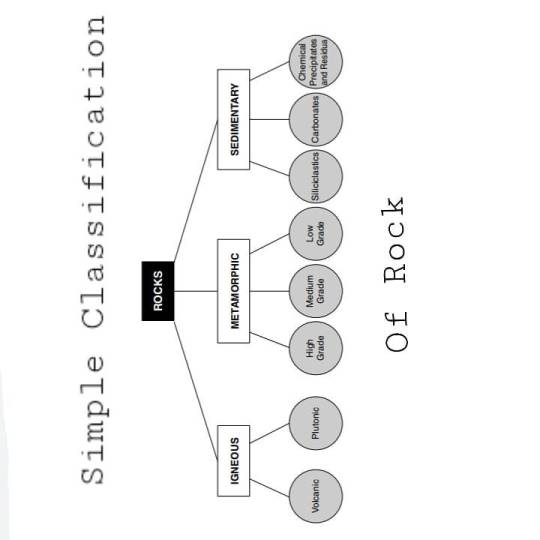
Rock and Forensic Science
👉 A rock may be defined simply as a mass of solid matter that is composed mainly of mineral crystals or grains that are texturally intergrown or held together by some form of cement.
👉 Pieces of rock have several attributes which can potentially be used as a basis for forensic comparison, including size, shape, surface texture (including weathering rinds and coatings), density, color, chemical composition, mineralogical composition, internal textural layering, fabric, magnetic characteristics, fossil assemblage (both macrofossil and microfossil), and age.
👉 Three main rock groups are:
🌑 Igneous,
🌑 Metamorphic,
🌑 and Sedimentary.
Each of which can be sub-divided, are traditionally distinguished.
#forensics#forensicscience#crimescene#forensic#criminology#forensicfield#forensicmcq#forensicquestionandanswer#forensicstudy#forensicinvestigation#evidence#forensicbiology#suspecteddocument#forensicknowledge#forensictoxicology#physicalevidence#questioneddocument#forensicexamination#forensicintro#forensiceducation#netjrf#forensicnetexamination#rock#cementadulterant#rockandforensic
3 notes
·
View notes
Text
A look at 7 species of maize (corn) being domesticated in different bioregions of Mesoamerica and the American Southwest before 2500 BC. Nice maps and timelines:
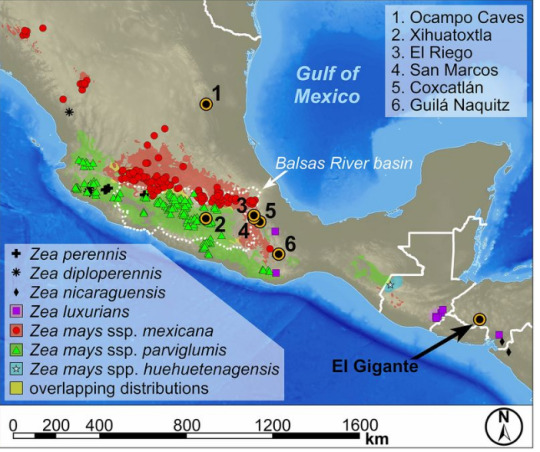


----
A timeline of maize use at different sites extending back at least 9500 years:

------

From:
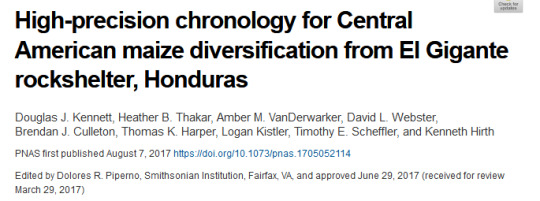
Abstract: The first steps toward maize (Zea mays subspecies mays) domestication occurred in the Balsas region of Mexico by ∼9,000 calendar years B.P. (cal B.P.) [...]. Molecular and microbotanical data provide a partial picture of the timing and nature of morphological change, with genetic data indicating that alleles for some domestication traits were not yet fixed by 5,300 cal B.P. in the highlands of Mexico. Here, we report 88 radiocarbon dates on the botanical remains from El Gigante rockshelter (Honduras) to establish a Bayesian chronology over the past ∼11,000 y spanning the transition to maize-based food production. Botanical remains are remarkably well preserved and include over 10,000 maize macrofossils. We directly dated 37 maize cobs to establish the appearance and local change of maize at the site. Cobs are common in deposits dating between 4,340 and 4,020 cal B.P., and again between 2,350 and 980 cal B.P. [...] Our results indicate that domesticated landraces of maize productive enough to be a staple grain existed in Central America by 4,300 [years before present].
41 notes
·
View notes
Photo

Hand chiseled/carved limestone plaque of a lion tearing flesh. "A" under the lion's torso, possibly a "C" formed by a portionnof the lion's tail. "NCANTAM" below the lion's feet. Latin?? The style of the lion's mane and head are not modern. The age of this is unclear. Limestone measures 12" square and 1" thick. Chisel marks and macrofossils are clearly visible on the polished surface. #limestoneplaque #lionplaque #carvedstone #unknownage @iowacityart (at Iowa City Art & Antiques) https://www.instagram.com/p/CUGomfho1_T/?utm_medium=tumblr
0 notes
Text
Fwd: Postdoc: UppsalaU.PhylogenomicsAndMolecularClock
Begin forwarded message: > From: [email protected] > Subject: Postdoc: UppsalaU.PhylogenomicsAndMolecularClock > Date: 25 February 2016 at 07:48:37 GMT > To: [email protected] > > > Postdoc/Researcherin Systematic Biology > > UppsalaUniversity is an international research university focused on the > development of science and education. Our most important assets are all > the individuals who with their curiosity and their dedication make Uppsala > University one of Swedenขs most exciting work places. Uppsala University > has 40,000 students, 7,000 employees and a turnover of SEK 6,5 billion. > > Description:Resolving the global tree of life has long been a main > goal of Biology. In recent years, breakthroughs in high-throughput > sequencing and faster phylogenetic algorithms have allowed to refine > the structure of the tree in unprecedented ways. For eukaryotes, all > major groups as well as many once enigmatic lineages now have genomic > data available. This wealth of data has opened the door to study the > deep relationships among eukaryotes with more confidence, and map onto > the tree some of the main evolutionary events. Here, we propose to > go further by combining phylogenetics, genomics (i.e. phylogenomics), > and molecular dating to address long-standing questions in eukaryote > evolution, such as the origin and spread of plastids. For this purpose, > we will infer a genomic timescale calibrated with the microfossil record > of protists, which presents the key benefit of being continuous and > thus more comprehensive than macrofossils. This is a timely project at > the forefront of microbial genomics and evolution, within a motivating > scientific environment that will lead to some exciting developments in > understanding the diversity of eukaryotes. > > Qualifications:Depending on seniority, this position will be filled > either as postdoctoral fellow or researcher. Eligible for employment as > postdoctoral fellow are those who have a doctoral degree or a foreign > degree found to be equivalent with a doctoral degree, obtained within > three years before the deadline for applications. If there are special > reasons, the degree may be older than three years. Special reasons > refer to absence due to illness, parental leave, commissions of trust > within trade unions or other similar circumstances. Eligible for > employment as researcher are those with a doctoral degree older than > three years. Candidates must be fluent in English with strong writing > skills. This position is for 2 years. > > Assessment:I am looking for a highly motivated individual with > strong academic proficiency within the field of (microbial) eukaryote > evolution. Proven experience in bioinformatics to handle genomic-scale > datasets, phylogenetics, and molecular dating will be highly > valued. Documented skills in phylogenomics would be an asset. > > Application:The application should include a letter in which the applicant > describes oneself and the research interests (one A4 page) and contact > information for three references. The application should also include > CV and a copy of the doctoral degree. Personal circumstances (such as > parental leave) that the assessment of qualifications may be credited > to the applicant, should be indicated in the list of qualifications > and experience. > > UppsalaUniversity is striving to promote gender equality through gender > balance. The majority of employees in this category are women, which is > why we would like to see men as candidates for the position. > > Informationabout the position will be given by Fabien Burki: > [email protected](from March 1st) or [email protected] > > Moreinformation can also be found here: > https://ift.tt/3jXq5jG > > > > [email protected] >
via IFTTT
0 notes
Link
First macrofossil record of Calophyllum in Thailand reported – The Lifestyle Insider
0 notes
Text
In ‘Moon Landing of Genomics,’ Scientists Sequence Ancient DNA From Dirt
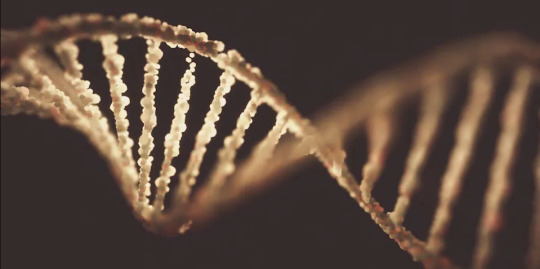
Scientists have pieced together multiple entire ancient bear genetic codes from soil sediment.
The secret is using whole genomes as templates to reconstruct the ancient DNA.
Scientists now have a whole floodgate of new genetics to open up.
Scientists have achieved a breakthrough they’re comparing to the moon landing: sequencing a full ancient genome from soil samples.
How’s that on par with humans touching down on the lunar surface? Well, the research team from the University of Copenhagen found the entire genetic code of an ancient bear species without obtaining it from fossils, marking the very first time scientists have found genes outside the fossil record. And by gathering the DNA from the soil, these researchers gathered a bunch of examples, rather than just one single specimen’s genome.
The scientists found the ancient bear genetic material in the soil of Chiquihuite Cave in rural Mexico. Like the ancient Chauvet Cave in France, Chiquihuite contains some of the oldest human evidence in the world—but humans weren’t the only ones to use the caves.
The ancestral bear DNA dates back to about 16,000 years ago, and it comes from an unsavory, but logical source: bear waste.
“When an animal or a human urinates or defecates, cells from the organism are also excreted,” geneticist Eske Willerslev told ScienceAlert. “We have shown that hair, urine, and feces all provide genetic material which, in the right conditions, can survive for much longer than 10,000 years.”
From there, the researchers assembled the pieces of environmental DNA (eDNA). “Standard eDNA techniques allow species to be determined [without] macrofossils across a variety of environments including sediments, ice cores, lakes, rivers, and oceans,” the scientists explain in their paper, which appears in Current Biology.
Printing in China
So how did the team assemble the bears’ genome from these environmental scraps?
“We estimated a mitochondrial phylogeny using whole mitogenomes of the eight extant bears of the family Ursidae as well as three extinct bear lineages: cave bears (U. spelaeus) and the two extinct tremarctine bears, the North American giant short-faced bear, Arctodus, and the South American giant short-faced bear, Arctotherium, which we reassembled using the Andean bear as reference.”
Basically, the scientists patched together the complete ancient genome using modern and extinct bears as templates—think about using a model of a bottlenose dolphin as a guide to assemble the body parts of a killer whale. The parts aren’t exactly alike, but both animals have a dorsal fin and a blowhole.
Fossils offer scientists a huge amount of information, but the fossil record is spotty by nature, and doesn’t make sense to rely on as something to fully inform us about everyday activities and whole populations of animals. For example, one full T. rex specimen, while spectacular, doesn’t explain what the whole species’ genetic information was like.
Willerslev told ScienceAlert this research is “the moon landing of genomics” because it allows study of the genome without any fossil findings—bringing with it a vast wealth of new genetic information that can be gleaned fully from soil and other sediment.
0 notes
Text
Scientists in Japan just found a Detailed Record of Earth's Last Magnetic Switcharoo
https://sciencespies.com/space/scientists-in-japan-just-found-a-detailed-record-of-earths-last-magnetic-switcharoo/
Scientists in Japan just found a Detailed Record of Earth's Last Magnetic Switcharoo

Every 200,000 to 300,000 years, Earth’s magnetic poles reverse. What was once the north pole becomes the south, and vice versa. It’s a time of invisible upheaval.
The last reversal was unusual because it was so long ago. For some reason, the poles have remained oriented the way they are now for about three-quarters of a million years. A new study has revealed some of the detail of that reversal.
The study of the Earth’s magnetic field is called paleomagnetism. It involves the study of rocks and sediments and sometimes archaeological materials. Rocks that were once molten retain a record of the Earth’s magnetic field as they solidified.
The related field of magnetostratigraphy studies the record of geomagnetic reversals that are contained in those rocks. By dating the rocks, researchers can construct a timeline of the Earth’s reversals.
The last reversal is named the Matuyama-Brunhes geomagnetic reversal after the co-discoverers: Bernard Brunhes, a French geophysicist, and Motonori Matuyama, a Japanese geophysicist. Over the years since its discovery, researchers have tried to understand exactly when it happened, and also how long it took.
This new study is titled “A full sequence of the Matuyama–Brunhes geomagnetic reversal in the Chiba composite section, Central Japan.” The lead author is Yuki Haneda, a project researcher at the National Institute of Polar Research and a postdoctoral research fellow at the National Institute of Advanced Industrial Science and Technology in Japan.
The paper is published in the journal Progress in Earth and Planetary Science.
Lava flows are a reliable indicator of the orientation of Earth’s magnetic poles at the time the lava solidified. But what they can’t provide is a timeline. They’re more like snapshots that freeze a moment in time.
Lava flows are very helpful when it comes to understanding the Earth’s magnetic field at the time of solidification. “However, lava sequences cannot provide continuous paleomagnetic records due to the nature of sporadic eruptions,” lead author Haneda said in a press release.
A better record can be found in some sediment deposits, which can form over a long period of time. One of these deposits is called the Chiba composite section. It’s in Japan, and geophysicists consider it to be a very detailed record of the Matuyama-Brunhes reversal.
“In this study, we collected new samples and conducted paleo- and rock-magnetic analyses of samples from the Chiba composite section, a continuous and expanded marine succession in Central Japan, to reconstruct the full sequence of the Matuyama-Brunhes geomagnetic reversal,” Haneda said.
The Chiba composite section is widely considered to contain the most detailed marine sedimentary record of the Matuyama-Brunhes geomagnetic reversal, according to Haneda.
It serves as the international standard for the lower boundary of the Middle Pleistocene Subseries and Chibanian Stage — when Homo sapiens emerged as a species.
The Chiba composite section is notable for its well-preserved pollen and marine micro- and macrofossils. It also contains tephra beds. Tephra is a fragmentary material produced by volcanic eruptions, normally referred to as volcanic ash.
All in all, Chiba provides the most reliable chronostratigraphic framework of the time period around the Brunhes-Matuyama reversal.
What they found goes against what some other studies have uncovered, especially when it comes to how long the reversal took to occur. Some studies suggest it took several thousand years, while another suggested that the reversal was completed in one human lifetime.
The different time estimates depend largely on where on Earth researchers gather their evidence. This study based on the Chiba composite section says it took about 20,000 years, including a 10,000 year period of instability leading up to the reversal.
“Our data is one of the most detailed paleomagnetic record during the Matuyama-Brunhes geomagnetic reversal, offering deep insight into the mechanism of the geomagnetic reversal,” Haneda said.
The marine micro-fossils and pollen found in the Chiba composite section also hold clues to the magnetic reversal. The team of researchers is going to investigate fossils and pollen next to try to learn more.

This figure from the study shows the location of the study area on Japan’s Boso Peninsula. (Haneda et al., 2020)
The question that looms over Earth’s geomagnetic reversals is ‘What effect do they have?’ That’s outside the scope of this study, but it’s the focus of other research.
Some researchers have wondered if magnetic reversals have contributed to climate change. While the evidence is nowhere near complete, some scientists have outlined how reversals might play a role.
In 2006 a team of researchers made a presentation to the American Geophysical Union’s Fall Meeting titled “Does the Earth’s Magnetic Field Influence Climate?“
When mentioning the accepted causes of climate change on Earth, the team said, “Magnetism has seldom been invoked, and evidence for connections between climate and magnetic field variations have received little attention.”
“The most intriguing feature may be recently proposed archaeomagnetic jerks. These seem to correlate with significant climatic events.”
Archaeomagnetic jerks are quick changes in the Earth’s geomagnetic field that are localized rather than global. While there’s only a correlation between them and climate, a causal link might one day be established. Could there also be a causal link between magnetic reversals and climate?
The effect that magnetic reversals have on animals is likewise a fascinating and open question. Many animals undertake long, migratory voyages. Whales, birds, and sea turtles, for example.
And there’s evidence that some migratory species rely on Earth’s magnetic field to navigate. The phenomenon is called magnetoreception.
How are creatures that rely on magnetoreception affected by geomagnetic reversals?
During a reversal, the magnetic poles not only switch places but the field strength drops. There may also be temporary poles at the equator or even multiple temporary poles. The poles can also wander around, leaving their original position and returning before eventually switching completely.
It’s not clear what effect a reversal has on animals. But there’s some evidence that solar storms, with all their magnetic activity, can create confusion for migrating whales and may even drive them to beach themselves.
During a reversal, the protective effect of the Earth’s magnetic field is reduced. More solar radiation may reach the surface of Earth during a reversal, which could put animals like whales in peril the same way a solar storm might. However, the evidence for this is not clear.
In any case, life on Earth has survived many geomagnetic reversals, and still, life thrives. Modern humans haven’t faced one yet, so observing the next one will be very instructive.
The most likely effect will be on our power and communications systems, including satellites. As the global magnetic field weakens, more of the Sun’s radiation can get through. We know from things like the Carrington Event that that scenario can be very damaging.
While this study can’t address all these questions, it does advance our understanding of the previous reversal.
“Our results provide a detailed and expanded sedimentary record of the M–B geomagnetic reversal and offer valuable new information to further understand the mechanisms and dynamics of geomagnetic reversals,” the authors conclude.
This article was originally published by Universe Today. Read the original article.
#Space
0 notes
Text
Plant macrofossils and palaeoclimates
Plant macrofossils and palaeoclimates

Jack Wilkin (UK)
Palaeoclimatology is the study of past climates and environments using climate proxies, that is, the preserved physical characteristics of past, rather than using direct measurements of variables, such as temperature, levels of CO2 and so on. Many different types of proxies are used including, but not limited to, ice cores (Petit et al., 1999), lake and ocean sediments (Cehn e…
View On WordPress
0 notes
Text
International Day of Women and Girls in Science
By: Kelsie Tetreau
February 11 marks the International Day for Women and Girls in Science, a day that recognizes the critical role women and girls play in science and technology communities. The Royal Alberta Museum is fortunate to have some incredible female scientists on staff. For example, the Earth Sciences team of ten staff includes eight amazing female scientists!

RAM Earth Sciences Team pointing at all the glass ceilings they’re breaking: Back (L-R) - Matthew Bolton, Chris Jass. Middle (L-R) – Alwynne Beaudoin, Diana Tirlea, Christina Barron-Oritz. Front (L-R)- Amandah van Merlin, Emily Moffat, Katherine Bramble, Melissa Bowerman. Missing: Shauna Coombs
Today, we would love to introduce you to three of them: Melissa Bowerman, Diana Tirlea, and Diane Haughland of the Alberta Biodiversity Monitoring Institute (ABMI). (Note: ABMI is an arms-length, not-for-profit organization that partner with the RAM on research).
What do you do here at RAM?
Melissa Bowerman: I have been leading the Geology Program at the museum for 10 years as the Assistant Curator of Geology.
Diana Tirlea: I am the Assistant Curator for Quaternary Environments. My roles include maintaining the labs and equipment, providing access to the Seed and Pollen Reference Collection to the public, conducting research using pollen and macrofossils to reconstruct past landscapes and making this accessible to the public through publications, presentations and outreach.
Diane Haughland: As the ABMI Lichen specialist, I do research on lichen ecology, taxonomy, and biodiversity monitoring methods. My team of four wonderful women is responsible for identifying 15,000-25,000 lichens each year collected by the ABMI. I also train field technicians, teach, and supervise graduate students.
What first made you interested in science as a career?
Melissa Bowerman: A museum program! I attended a program at the former Edmonton Space and Science Centre. I believe the program was called the Challenger Program and it let students take on roles in a space flight scenario. It was a remarkable experience that sparked a life-long interest in space and science.
Diana Tirlea: Growing up I enjoyed being outdoors, learning about the different animals and plants I encountered. I was an observer and I saw beauty in the world, tiny and large things. My passion for knowing and learning about my surroundings led me to pursue a science career.
Diane Haughland: I was more of an artsy kid; up until high school, I equated science with anatomy and medicine. As an undergraduate, I discovered botany and ecology, and that metaphorical light bulb went off. Already an avid hiker and camper, they brought extra layers of meaning and joy to my outdoor adventures. Asking curiosity-driven questions that have conservation implications? I was hooked.
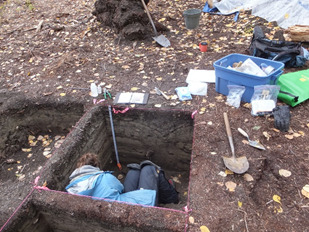
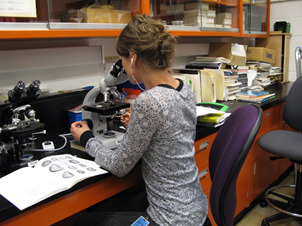
Diana Tirlea hard at work, both in the ground and in the lab!
What was your education and career path that lead you to your current job?
Melissa Bowerman: I completed an undergraduate degree in Geology at the University of Alberta. I was fortunate to gain abundant field experience early in my career – in places like the Canadian High Arctic, the Canadian Cordillera and Hawaii. I went on to complete a master’s degree investigating the metamorphic history of the Canadian Shield in northern Manitoba. I also spent time working for a mining exploration company on projects in the Northwest Territories and Yukon before landing at the Royal Alberta Museum. This job turned out to be a perfect opportunity for me to combine my love of teaching with my passion for science.
Diana Tirlea: My career path was definitely not straightforward. A big part of my career development was obtaining a broad range of experiences and skills through volunteering, working, taking courses, completing an internship and connecting with people in the science field.
I started my education at MacEwan College intending to complete my pre-veterinarian courses. I decided I preferred animal biology and completed a major in zoology at the University of Alberta. Between my 3rd and 4th year at university, I completed an 8-month internship working on wetlands and plants. After completion of my undergraduate degree, I took a few years off to work as an environmental consultant. I returned to the U of A to complete an MSc in Ecology, where I focused on reconstructing changes in past environments using pollen analysis and pigments. After completing my MSc I worked as a vegetation ecologist until I began working at the Royal Alberta Museum. The skills I have developed through my education, volunteering and work experiences and through the many individuals I have networked with contributed to success I have had at my current position.
Diane Haughland: As an undergraduate, I was determined to be a veterinarian. After job shadowing a vet, discovering ecology, and with the encouragement of professors, I instead pursued science through a Master’s degree. After teaching at a university, I wanted to be better at asking ecological questions, experimental design and statistics so I went back for a doctorate. My PhD was in the science of biodiversity monitoring. While I worked with birds, soil mites, mosses, and plants, it was the lichens that grew on me. I worked hard to grasp their taxonomy and that skill set helped me secure my position, as Lichenologist for the Alberta Biodiversity Monitoring Institute (ABMI).
What is the coolest thing you have had the opportunity to do in your career?
Melissa Bowerman: The hottest thing I have done in my career is get up close to lava not once, but twice. While watching lava flow in Hawaii, I was surprised to discover lava makes noise - it crackles and pops. Flakes of glass popping off the surface of the lava causes the sound. I was desperate to interact with the lava but the only thing I had in my pack was carrots. I can confirm – carrots burst into flame in lava.
Diana Tirlea: Hmmm, it is hard to pick just one thing. It ranges from “big” cool thinks like coring peatlands, helicopter rides (to study site), and rehabilitating bald eagles, to “small” things like finding preserved seeds from melting glaciers! It is also very awesome to share my research work and experiences with people and meeting interesting and passionate researchers at conferences.
Diane Haughland: Do I have to name just one? I love the travel – to explore ecosystems with other nature nerds, whether it’s in southern Alberta or on another continent is awesome. To hike, quad or helicopter into sites that few people have seen is humbling, and to see them from a different perspective. For example, I introduced a long-time rancher to the dozens of hidden lichens living literally beneath his feet. I’ve helped discover new species to science, and designed survey methods for province-wide monitoring. The challenges are never-ending, and that’s really the coolest part of my job.
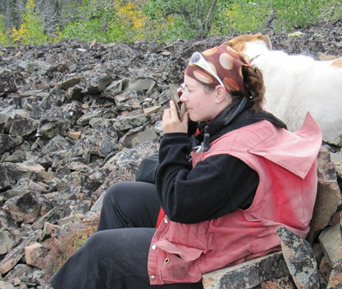
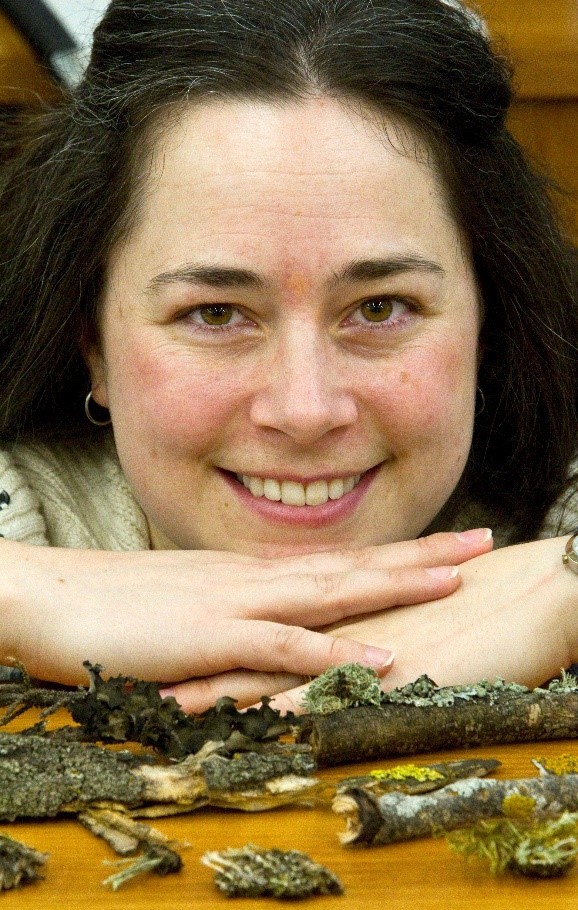
Diane Haughland and her lichen-y friends.
Tell me about a time you had an opportunity to share your knowledge and contribution to the scientific community?
Melissa Bowerman: I cherish every opportunity to teach students in the field. Geology is a subject best taught outside and on the rocks. The backdrop of the Rockies makes for a fine classroom.
Diana Tirlea: Recently I presented to a plant study group on how we can use pollen and seeds to reconstruct past landscapes. We discussed different features used to identify pollen and seeds and we examined seeds under a dissecting microscope to look at differences in size, shape and morphology. Following this presentation, two people contacted us to discuss or use the RAM Seed Reference Collection (over 2260 specimens) to identify their samples.
Diane Haughland: I was part of the ‘provocative speaker series’ at a Telus World of Science adults-only event, “Dark Matters: the Science of Sex”, where I compared lichen sexuality to the wonderful variety in human relationships. For communicating with other scientists, publications are critical. They can be a lot of work but science is often advanced through incremental progress – it’s nice to contribute one of those increments.
Do you notice a shift in equality and parity for women in science?
Melissa Bowerman: Most geology classes at the undergraduate level are split evenly between men and women but that balance does not happen as often at advanced career levels. I have witnessed progress in the short span of my career and I hope to see more.
Diana Tirlea: There seems to be a lot more women in science now; however, there is still a real lack of women represented in executive positions. However, there are many opportunities for women and girls to enter a science career today, including many internships and summer job opportunities for women. In addition, many science careers and organizations support women with families, including stay-at-home opportunities such as preparing scientific reports or editing journal articles.
Diane Haughland: The statistics show that more women are entering science, but the science shows that there are still (often unconscious) biases against women, particularly as they progress in their careers. Focusing on that can be counterproductive, which is why I’ve learned to focus on the process, skill development and critical thinking. I encourage my students to use all resources available to them to ensure they are confident in their contributions. We’ve come so far in the last 50 years and I’m optimistic our realized opportunities as women will only increase.
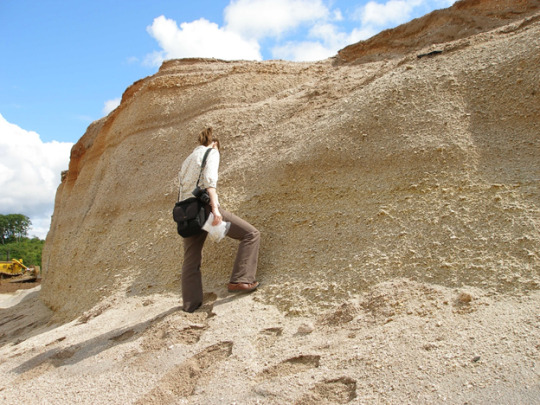
Melissa Bowerman examining a pumice deposit in Hokkaido, Japan
What is your advice to young girls interested in pursuing a career in science?
Melissa Bowerman: I do not subscribe to the idea of being naturally good at a particular subject. If science is your passion, hard work is the ticket to success.
Diana Tirlea: To help determine your career path, explore your interests through volunteering, working and interviewing people from different organizations. Do not be afraid to change your career path based on your experiences (e.g., volunteering). Some careers may seem exciting and interesting, but you need to experience them beforehand. For example, I love working with small specimens (e.g., seeds) and microscopes and I can do this for hours. By networking, having many different experiences and connecting with people in your field of interest, you can align your passions and your individuality with your career. This will lead you to personal and professional success!
Diane Haughland: It’s cliché, but do what you love and do it to the best of your ability. Define your own balance. I love my work and I spend more time on it than I’m paid to, but that’s because the work is the reward. Realize you don’t have control over whether you get a certain job, but you do have control over how you spend your precious time. And take care of yourself, always.
1 note
·
View note